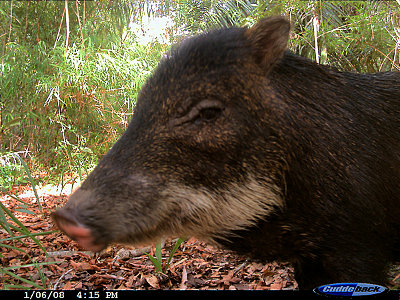 White-Lipped Peccaries are found in the Cerrado and Pantanal forests of South America.
White-Lipped Peccaries are found in the Cerrado and Pantanal forests of South America.
Peccaries, or Queixadas, as they are locally known as, are the unsung, misunderstood heroes of environmental engineering in the Cerrado and Pantanal biomes of South America.
Peccaries might have certain physical attributes and characteristics similar to pigs and warthogs; however, contrary to popular opinion they do not belong to the same family. They do wallow in the mud and use their snouts to dig up fruit, seeds and roots, just like pigs and warthogs, but similarities stop there. One major difference is that the canines of pigs and warthogs never stop growing – therefore they end up growing right through the top of the pigs’ snouts – sealing them shut, leaving the emaciated animal to slowly starve to death. Peccaries are also not omnivores. They feed mainly on fruit but are known to supplement their diet with plants and roots.
Peccaries can grow up to 130cm and weigh about 32kg. They have 4 large canines in the front of their mouth – used for warding off predators and their molars help them crush seeds. In the bush, you can hear them clamp their teeth shut – like slapping 2 wooden rulers together. They have about a 1 to 1 sex ratio and travel in big herds ranging from 20-100 individuals, like a big family hike through the forest. Peccaries are unique in that they are gregarious ungulates * – but are not sexually dimorphic – which is unique for ungulates. They are also unique because they give birth to twins, usually a pair a year. When peccaries encounter a predator, they scatter like marbles in all different directions to cause confusion. This behavior has given birth to an urban legend that the peccaries actually surround people and kill them. However, peccaries will not harm people.
They have very important roles in the ecosystem. Acting as forest engineers, they change habitats and allow for the succession of different animals and plants. They aggregate around trees bearing fruit that they like and feed off the fallen fruit on the forest grounds. In doing so they churn up the soil, bury seeds, and create a perfect environment for new plants to grow. Peccaries also play multiple ecological roles, acting both as seed predators and dispersers as well as being an important part of the diet of large carnivores, such as jaguars and pumas. Since peccaries are on both ends of the food chain, a decrease in their numbers can disrupt the entire ecosystem. Peccaries are highly sensitive to environmental degradation since they rely so highly on various species of fruit trees and degraded forests are not able to provide a sufficient amount of food. Due to this, they are indicators of healthy forests.